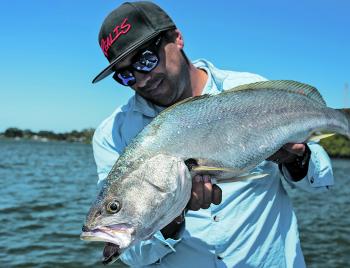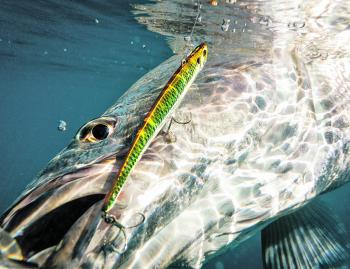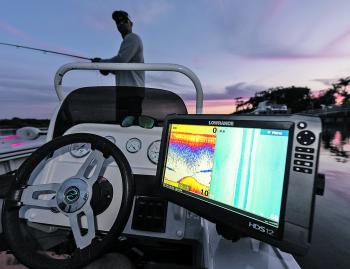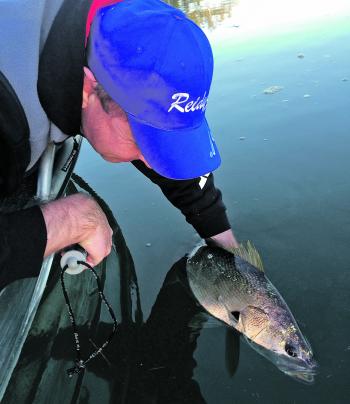The warmer months are a great time to hit the estuaries in search of NSW’s ghost of the estuary, but many struggle to crack a pattern on these impressive silver slabs. It doesn’t have to be complicated, and often, if you can just break down a certain waterway, it can be very simple to find a decent school of mulloway.
To begin your search, always look for structure. Mulloway always need a reason to be there, and structure is often that reason.
Structure is always important for finding mulloway, particularly in rivers. I tend to look for depths of 15ft down to 30ft with a rock structure. On the edge of that where it meets the sand is always a hotspot, particularly with rock walls.
My fishing isn’t always centred around structure I can see out of the water though. Other areas where a creek mouth might drain out into a big hole in the river is also worth a look. When you’re fishing vibration lures for the mulloway, it’s almost like a vertical hop, and you’re trying to use your electric sounder to judge the edge of the drop-off. Because of this, you want a good reliable sounder that’s going to help you find the structure and bait exactly, and the actual school of fish as well.
It goes without saying that most avid mulloway anglers have good sounders in their boats, and I’m no exception.
I use a Lowrance Gen3 HDS 12 Touch unit because it has Insight Genesis maps that let me map the contours in the rivers, so I know what edge to drift along. The main consideration with a sounder though is that it has structure scan, so you can look out to the side, and downscan so you can get a good picture of what’s below, plus regular sonar. I keep three windows open so I can see each picture.
A good knowledge of your sounder’s capabilities is important when finding mulloway schools, and can make the difference between a great day and an average one.
Once you sound the fish up in the river, you’re pretty much going to get the bite straight away once you’re on top of them and you get a lure in their face.
Timing your sessions around conducive bite periods is probably the most important thing when chasing mulloway in our estuary systems, and while I’m often pressed for time with work commitments, I try my best to be on the water when the mulloway are biting.
The main consideration is the tide. I’ve found that the fish I’ve caught have mainly been at the bottom of the tide or the start of the run-in. The best times for fishing a river are when the tide change coincides with low light conditions – early morning, late afternoon and into the night. Although you can catch them in the middle of the day, it doesn’t happen as often. Part of that would be due to boat traffic, which is always heightened in summer.
There are exceptions to the rule though, and major flood events are one of them. If you’re fishing rock walls, it’s always a good time after you’ve had a good rain event because it pushes the bait out into the river.
The reason most people target mulloway is for the fight. These silver slabs go hard around structure, and can make long, hard and line-burning runs in an attempt to gain their freedom. Knowing their habits on the end of a line can help you to turn their heads away from structure and get them to the boat.
The fight is generally fast and furious until you wear them out, then you can start to put the pressure on after their first few runs. They’ll usually give up after a while and you can get them to the surface. Initially, once they realise they’re hooked, they’ll take a big run. After the initial bite, I always try to set the hook in and make sure I’ve got a solid hook-up.
With the vibes and soft plastics, they’ll usually hit it on the drop, so I’ll set the hooks in pretty hard and let them do their run, which really cements that hook-up.
Once you can get them away from their structure, they’re usually nice clean fighters, and you don’t get busted off much.
If you’re land-based fishing, a big one can potentially do a big run for about 100m or so, but then you can start to turn their head and bring them to shore, because this tires them out.
I use a variety of lures for my mulloway fishing, but have found confidence in a few select lure types and brands.
For plastics, I like them on a pretty light jighead, around 1/8oz. I’ll usually hop it twice, trying to keep it as low to the bottom as possible, just lifting it 6 inches to a foot off the bottom. It’s generally two hops, then I let it slowly flutter down.
The 3” Gulp Minnows are good in the natural colours like banana prawn and pearl watermelon. Plenty of 3-4” plastics will do the job. Other plastics that have worked well for me are the Keitech Swing Fat paddle-tails, and the DUO Realis V-Tailed Shad, which is almost a cross between a shad tail and a paddle-tail. They’re my go-to plastics around the shallower structure in around 8-15ft of water.
Rods are a huge consideration when chasing mulloway, and Scott doesn’t leave anything up to chance, opting for quality equipment.
A good-quality, fast-actioned rod with a sensitive tip is good because you can stay in contact with your plastic the whole time. Try to keep the rod tip high, because it’s easier to get the smaller hops out of it on the bottom. While your rod tip’s high in the air, you can’t jerk it too much, and it forces you to keep your movements subtle.
Most of my mulloway are school class fish, so I select his gear accordingly. I tend to use lighter gear when chasing schoolies in the river, with most fish around 70-80cm. I do occasionally get fish up to a metre, but they’re rare in the areas I fish.
When I’m going finesse to get the bite, I use a light 2-5kg spin outfit with 10lb braided mainline on a light spin 13 Fishing Envy rod. On this I generally have my Daiwa Exist spin reel in size 2500. I’ve found that 12lb fluorocarbon leader is a good balance. I’ve used lighter leader, but I’ve lost a lot of fish going lighter than 12lb.
In deeper water around holes I like to use big lipless crankbaits or light metal vibes. Trying to match the hatch is very important, so you should try to find out what bait is in the area.
Having a variety aboard is helpful for finding what they want on a given day, or night, and I’m always well-armed. I have a selection of lures with different actions, some have a wider wobble while others have a tighter action that’s more subtle, imitating a prawn cruising through at that time of the tide. Sometimes rattles work better than silent, or vice versa. You need to vary the lures to see what works on the day.
You’ll want to bring a range of sizes too, from 40-70mm. That way, you can look around the area and see what baitfish there are, and match the hatch. I’m sponsored by DUO, so I mostly use the DUO Realis Vibration baits, usually in the 62mm size. I prefer natural colours like golds, chromes and even some transparent colours.
Soft plastic tackle and vibe tackle is usually different, and I have a special outfit I use when vibing for mulloway. When I’m hopping vibes off the bottom, I fish heavier, because if you get snagged, you want to be able to straighten the hooks a bit and get your lure back. I use a 10-20lb baitcaster rod with a fast action. My chosen rod is a 13 Fishing Envy 7’0” with a Daiwa Z200H. For lines I like 30lb braid and 30-40lb leader
When fishing land-based for these estuary jewels, anglers often opt for moving baits to cover water. When I’m on the bank off the rocks, I like to throw bigger swimbaits, crankbaits and sometimes jerkbaits to imitate the mullet that are getting pushed out by the tide or fresh flow.
The key with swimbaits is to work them really slowly, because you’ll have a bit of current pushing out. You want to work them where the eddies are, which is where the baitfish are holed up.
You can use lures up to a 120mm for a bibbed minnows and jerkbaits. For swimbaits, anything up to 180mm will still get eaten. Big swimbaits don’t have to go down that deep, especially when the mulloway are feeding up top, so 2m is as deep as they need to go, you just want a slow steady retrieve.
Again, with crankbaits, jerkbaits and swimbaits, I have found confidence in a select few that work for me. The DUO Realis Sang Bait 140 minnow, which has a tight rolling action when the lure’s rolling, is desirable when you’re using a minnow for mulloway, but I’ll go down to a Realis 110 jerkbait. The Realis Onimasu 188F swimbait is my pick for swimbaits. There are plenty of other lures that will work well too, it’s just about finding the right size for the bait that’s being eaten.
I hope this is enough to get you out on the water in search of river mulloway. It’s not nearly as daunting as it sounds, and when you crack into your first few, you’ll have the confidence to catch more.
Go get ‘em!
NSWFM cover story
I was pretty sleep deprived after the flathead classic, where I’d been staying up late and then getting up early each morning for four days straight. I could have gone to bed, but I went mulloway fishing instead. The boat was still hooked up, so I was ready to do it. Impromptu jewie trips are the best!
It was after the Flathead Classic. I’d had enough of chasing flathead and wanted to chase mulloway in my local river. It was mid afternoon, just on the tide change. I was just searching around the usual spots, and came to a spot that was in 15ft of water with a bit of a rocky outcrop in the middle of the river. I got on top of the rocky outcrop, dropped the plastic down, trying to keep vertical and keep the speed of the drift right with the tide.
On the sounder I saw that I was over lots of fish. I imparted two hops of the plastic and then let it slowly flutter back down again.
I felt a tick in the line and struck! Once I set the hook it was on. It took me about 5-10 minutes to get it on board, but it measured around 75cm, which is typical for that area, and at that size they taste great.
Schoolies that size do have a bit of a smell about them, but when I fillet them and leave them in the fridge overnight, the smell seems to go away.
Reads: 5982
Mulloway are always beautiful when they come out of the water.

You do occasionally cross paths with a mulloway over a metre in rivers, particularly when there’s lots of fresh being pumped out of the system.

Big vibes are always a winner for schooling fish.

How’s that purple around the nose? They really are the jewels of the estuary.

Having a quality sounder on board is always helpful, particularly if you’re looking for schools.

Although mulloway taste good, many chose to put them back to fight another day.




